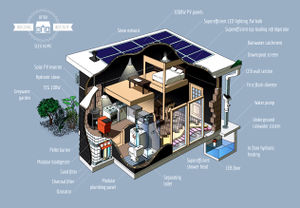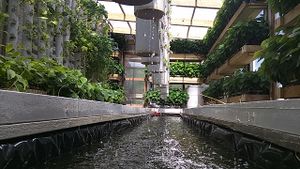Seed Eco-Home Log
Linked from Seed_Eco-Home_Index
Wed Dec 22, 2021
Replacing Flojet Macerator Pump - died - doesn't spin. Got an impeller kit, to fix the old pump from Mar 18, 2021 - but which sprung a small leak. Doing this as study of industry standards, to be opensourced. $27 cost for impeller kit.
Thu Mar 18, 2021
Replaced the macerating pump 2 weeks ago, as it sprung a small leak, possibly from hard carbonate buildup. Used a new pump that we had.
Photos - [1]. See also Seed Eco-Home Troubleshooting and Repair
Fri Aug 16, 2019
Thu Apr 11, 2019
156 kWhrs - total superfridge use since beginning of logging about 1.3 year ago. If our solar panels make on average 12 kWhr per day (2kW x 6 hrs including 30% cloudy days) - then the total time on our panels is about 13 days of power. Out of 356 days, that is about 4% spent on refrigeration. 156 kWhrs/(356*1.3*24)= 0.014 kW average usage rate or 14 Watt average. So about 2x the Mt. Best figure of 8 watt average power. Not bad, but needs work. The data keeping may be slightly off due to approximation of time started.
Mon Apr 8, 2019
So far the biodigester system has been a success. There were issues of smell from several fittings that weren't glued on the gas outlet, as we have yet to add the gas bag. There is a backflow to sink issue from the entry plumbing, as check valves don't work well with sink wastewater. Still need to upgrade inlet plumbing. The toilet, outside of the March 4, 2019 stuckage that was corrected with lye down the toilet - is seamless. The concept of a separating flush toilet made from a regular toilet - using weep hole and forced pumping to feed a digester- is as far as we know the first of its kind in the world, and reduces the cost of such a system by not requiring a specialized toilet. The system drains a septic fertigation to daylight, and that has now survived 2 winters without issue.
The next steps are adding ng the gas bag - after a year of track record we are ready for the next step. All the liquid plumbing is acceptable, next is gas plumbing, where this gets interesting as we move towards off-grid on gas.
Mon Mar 18, 2019
Mt. Best temperature drifted up, tried lowering temp on the Sparkfun Pro-Micro. First, and installing software on pro micro has package conflicts on Ubuntu. Pain to troubleshoot. Second, controller was not turning on. Decision - use a wall timer to do it. You really need 2x 1/2 hour per day, and that is it. Trying that next. We've been plugging the fridge in and out manually a couple of times - that works acceptably.
Thu Mar 7, 2019
Stove data. Due to pellet shortage in USA due to cold winter and pellet Mills burning down, we are running out of pellets. So back to hydro if stove. Stove temp, no forced air - 250C on outside heat exchanger. Top surface - 200. Burning dry logs. 100C behind bricks. Water pipe in 60C, out at 75C. Only 15C drop. Way overpowered for 4 300' circuits. Need to add more circuits to extract more heat. Floor at 25C, ceiling at 20C, second floor at 17C. Good log started is to use dry logs as base, top off with green stuff hlthat burns all night without restoking on low. There is a clear danger of overheat - this stove can do 200k BTU, so 2x the Microhouse stove heat, with half the hydronic circuits. A good night not fan would be able to do this well if forced air regulates the amount of heat, while having good capacity to throttle down by blocking air input. Would need a good blower assembly for this, with Arduino Thermostat.
Mon Mar 4, 2019
Biodigesters toilet stuckage. Used backflush feature at 50 PSI, which flushed out a clogg through the air admittance 2" pipe doelwn the drain. But not done yet. So poured 20 sporks of KOH down the toilet. That got all else out after about 1 hour chew time. Tested the backup drain (4" valve) - but nothing came out of that, just clean water and perfect flush. To activate 50psi backwash, pump is disconnected. Could use a switch for this. So this is after 1 year, March 2018. Preemptive be steps - maybe backflush test mode to test for stuckage? It's hard to see how this clig happened, but it was after the backup drain, which flowed freely. The backflush drain, in stuck condition, make water bubble out the toilet. This does not fix anything, but could be used to inspect for free flow of water down the drain. Under normal operation flush should be clear and vigorous, not barely sucking down a flush at the end of a flush cycle. Anyway, good solution is to plunge 1/2 - 1 cup lye down the toilet, wait need hour, and repeat if needed. For you nspection, there is the air admittance clean out, peep hole, backup drain, backflush, and weep hole blocking as possible operations. So it gets complex, and should be all automated. For the weep hole. For the weep hole - we want to close it so lye is not weeping down the drain in cleaning/unblocking procedure. All in all, works great. Preemptive step - toilet snake would be a good idea for a quick fix without lye. One time per year for 1.5 people is not bad so far, and I would say is acceptable to add spce to life without overburdening one's quest for self-determination.
Tue Feb 27, 2018
- Gas ovens use a lot of electricity! It turns out the electric heating element, which I thought was only turned on for ignition, stays on the entire time the oven is on. I can only use it during daylight hours on sunny days. I was told by another off-gridder that you can order custom ovens that won't do that, but we already invested on this one and I don't want to buy a new one. It would be great to find some sort of hack or alternative.
- Air drying clothes indoors is easy, but sheets and larger items are more problematic. The weather is too unstable/extreme (rain, freeze, etc.) to dry clothes outside. So I'm trying to think of some clever system to air-dry large items in a protected area.
- The top surface of the pellet stove is a great dehydrator! I've been using it to dry almond meal (to make flour with) and to proof bread.
Mon Feb 5, 2018
Since the next step is the digester, could you please also include the kitchen drain in the scope of work? The bathroom's p-traps seem to be working. I haven't felt any sewer gas smell since I began keeping the utility room door closed. But there is still a sewer gas issue with the kitchen sink (which does not have a trap). It is most definitely coming from the sink drain, not from the utility room.
What I can't figure out is what makes it happen. Some days there is barely any smell at all, other days it's strong and comes up every time I use the sink. I would expect that a sink without a p-trap would be venting sewer gas all the time. But it appears that sewer gas only comes up when water goes down the drain—it seems the water displaces the gas which then travels up. Can you make sense of this?
The other concern is that a similar thing will happen with the toilet once a macerating pump is added it to. If the toilet's p-trap is sucked dry every time we flush, sewer gas will come up.
We don't necessarily need to re-invent the wheel though as there are commercial macerating (upflush) systems we can learn from. I did some preliminary digging and found the following info:
Do macerating systems, gray water pumps and fixtures need to be vented? All macerators and gray water pumps have been designed with a vent connection on the lid. All plumbing codes require connection to a vent system. Please note that the vent system should be a two-way air vent. The use of mechanical vents, air admittance valves or similar devices are not permitted as these are considered one-way vent systems. The Sanicompact and Sanistar units are “forced mains” and they do not need to be vented.
Do I need to install a P-Trap in vanities, bathtubs, and showers? Yes, even though macerating systems have built-in mechanical traps most plumbing codes require a regular P-Trap to be installed. It is also necessary to prevent odors and sewer gases from escaping into the room.
References:
- https://www.homedepot.com/catalog/pdfImages/0a/0a8d763e-8705-4857-8e7e-d67a67191269.pdf
- https://www.saniflodepot.com/pages/installation-guides
- http://www.diynetwork.com/how-to/skills-and-know-how/plumbing/how-to-install-a-macerating-system
I understand that this is not the system we have, but please check out this video
https://www.youtube.com/watch?time_continue=103&v=YkeRtNvv6gY
on how commercial macerating systems work.
- Macerating systems are vented like any other plumbing fixture.
- Fixtures connected to the macerating systems do have standard p-traps and vents.
- If I understood it correctly, what prevents the p-trap from being drained by the pump is the fact that the impeller pump is separate from the macerating pump—it's sucking from a container rather than directly from the sink.
One possible solution is to add a p-trap to the sink and always manually fill both the sink's and toilet's p-traps after the pumps are done. This is not the most practical and is not as automated as we want this to be, but it's still better than sewer gas all over the house...
Could you please analyze this and propose a re-design solution?
Thanks, C
December 2017
See Open_Source_PV_System. Highlight: 2.3 cent/kWhr over 20 years, and 1.2 cent/kWhr over 50 year lifetime of PV system.
Fri May 19, 2017
Leaf eliminator printed successfully. Toilet platform install.
Thu May 18, 2017
First leaf eliminator installed. Printing the shorter leaf eliminators, try 2 in PLA, not ABS due to delamination.


